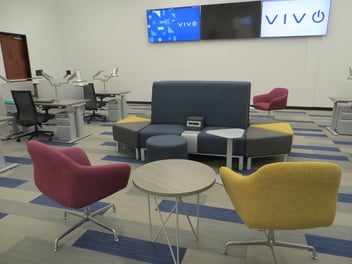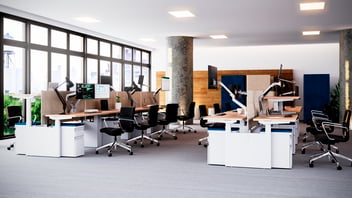Towards a Digitalized Office: Boosting Productivity with Technology
Today, digitalization is advancing rapidly; companies are constantly seeking ways to optimize their processes and enhance employee productivity through technology. The digitalized office responds to this need, creating an efficient, creative, and collaborative space.

The Digitalized Office: A Balance Between Technology and Analog Elements
A digitalized office uses technology to increase productivity and efficiency without abandoning analog elements. Digitalization involves an internal transformation that also encompasses the company culture. An example of this trend is the paperless office, where the use of paper is minimized across all departments, encouraging the use of cloud storage.
Beyond Automation
The digitalization of an office goes beyond task automation. It involves understanding employees' needs and how technology can address or enhance their skills. It's about creating a digital ecosystem that facilitates communication, collaboration, and information access, without losing sight of the importance of human contact and creativity.
The key to a successful office digitalization lies in the company culture. It is essential to create an environment where employees feel comfortable using technology and where innovation and adaptability are valued. Continuous training and support are crucial to ensure that all employees are prepared to make the most of new digital tools.
Benefits of the Digitalized Office
- Increased Productivity and Efficiency: Automating repetitive tasks frees up time for employees to focus on more strategic and high-value activities.
You may be interested: Teams Microsoft + Chat GPT: AI Boosting Productivity in Your Work
- Improved Communication and Collaboration: Digital tools facilitate communication between teams, even those in different locations.
- Real-Time Information Access: Employees have access to the information they need at any time and place, speeding up decision-making.
- Greater Flexibility and Autonomy: Employees can work more flexibly, adapting their schedules and workspaces to their needs.
- Cost Reduction: Digitalization can help reduce operational costs, such as energy consumption or paper usage.
- Data Analysis: Data collection and analysis can help optimize processes, identify new opportunities, and make data-driven decisions.
- Time Management: Multiple time management applications and tools available today can help employees be more productive and organized. A great example is Google Calendar, which we have already covered in a blog post.
- Increased Creativity and Innovation: Technology can be a tool to foster creativity and the generation of new ideas.
The Key to Balance: Analog Elements
While technology plays a fundamental role in a digitalized office, we must not forget the importance of analog elements. Physical workspaces, face-to-face interactions, and the use of traditional tools like filing cabinets for important physical documents and whiteboards in meeting rooms remain essential for fostering collaboration, creativity, and employee well-being.

Digitalizing an office is an ongoing process that requires commitment and constant adaptation. As technology evolves, companies must be prepared to integrate new tools and solutions that allow them to continue optimizing processes and improving employee productivity and experience.
In short, the digitalized office represents an opportunity for companies to adapt to new market demands and create a more efficient, creative, and collaborative work environment. By finding the right balance between technology and other elements, companies can harness their employees' talents and achieve success in an increasingly digital world.





